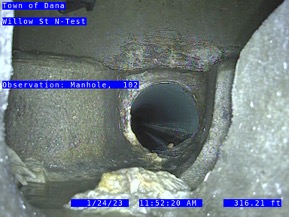Water Utility Digital Transformation

Our Nation’s aging utility infrastructure is gaining notable attention. Multiple factors such as the ongoing COVID-19 pandemic, an aging workforce, and natural disasters occurring more often, the need for utilities to transition to digital workflows is evident and the time to act is now. Many rural utilities are still reliant on paper utility maps and field operation workflows.
These paper-based workflows often result in inefficiencies such as lack of access to paper maps, weathered/aged paper, redundant data entry processes, illegible handwriting, and an inability to meet regulatory requirements with accurate data entry. Additionally, the aging workforce has been accustomed to performing their role relying solely on paper workflows and can be resistant to digital workflows.
This reliance on paper maps and workflows makes it more difficult to overcome industry challenges and is costlier to operate, thus the need for digital transformation. The benefits of digital transformation are well-known—such as reducing operations costs and providing a better system of records. This results in smarter asset management decisions, attaining better regulatory compliance, and having more satisfied customers.
Geographical Information Services (GIS) Bridges the Transition from Paper to Digital Mapping
GIS in its simplest form, is a tool that incorporates geographical features with tabular data in order to map, analyze, and collaborate. The pivotal piece of this technology is geography – meaning that the data is spatial. “Spatial” is defined as occupying a physical space on earth. Spatial data is usually accompanied by tabular data, known as attribute data. “Attribute data” is defined as additional information about a spatial feature. An example of this would be a water valve. The actual location of the water valve is the spatial data. Additional data such as valve manufacturer, type of valve, the date the valve was installed, and the number of turns to open would make up the attribute data. It is the partnership of these two data types that enables GIS to be such an effective tool through spatial analysis. To obtain the spatial location of the water valve, GPS (Global Positioning System) technology is used in conjunction with GIS software.
The benefits of utilities utilizing GIS are numerous:
- Knowing where infrastructure components are located
- Baseline for Asset Management
- Creating a singley, leads to improved records management
- Increased operational efficiency among workforce; data access available 24 hours a day, seven days a week in a secure cloud-based solution
- Improved proactive operations through efficient digital field operations and work order management procedures
- Decreased reactive operations
- Emergency preparedness and response
- Meet regulatory compliance reporting
- Transparency to the community and leaders
- Theft reduction by more optimized water loss capability
The process can seem overwhelming for a rural community. Data collection is just the first step. There are stages in which digital transformation can be modeled once a utility decides to make the transition.
Smart Water Network Forum (SWAN), a global non-profit organization focused on advancing digital transformation in the water and wastewater industry provides the following Benefits of Digital Transformation for Water Utilities. (Source: https://www.swan-forum.com/blog/#Idrica-Digital-Transformation)
1- Data is translated into actionable information
The evolution of water meters, in relation to their data collection capabilities and communication systems, has led to unprecedented streams of information, which utility managers can use to make critical decisions proactively. However, today utilities only thoroughly analyze, on average, about 10 percent of the data they collect (2015 CIO Forum).
When conveniently used, Automated Meter Infrastructure (AMI) can help utilities take their digital transformation to the next level. Data collection is just the first step. For it to be useful, large data streams must be translated into actionable information via powerful analytical engines, allowing end-users to rapidly understand and act. This means that utilities should move from a data-siloed organization to a data-centric one, having full transparency and interoperability. According to Jaime Barba, CEO Idrica and global smart water expert, “data means nothing if it can’t be turned into information”.
2- Managers can make better decisions for a resilient future
As consumer behaviors change and climate change accelerates, there is a growing need for long-term planning to drive business decisions, but also for making accurate short-term decisions. Water utilities must build resilience by identifying potential impacts and developing adaptation plans. To build a sustainable water future it is necessary not only to have the adequate infrastructure but also to control in advance what is going to happen and why.
3- Utilities can move towards a customer-centric approach
Thanks to technological innovations related to water meters, utilities can now become proactive in customer management. The internet has enabled the transformation of many companies, provides enhanced detail of client information which, used properly, provides added value services to customers, reduces complaints, and can support industrial customers to optimize the use of water intake in their processes.
The benefits of digital transformation involve higher transparency with citizens, companies, and institutions, who will become key agents for a resource that is becoming increasingly scarce, and for which their direct involvement is required.
4- Benefits of digital transformation: ROI is increased
The digitalization of water resource management means savings at both the operational and investment levels. By automating previously manual processes, a smart water approach in organizations generates greater efficiencies at a lower cost. Any water utility, regardless of its phase in its digital transformation journey, can see increases in return on investment (ROI) from past investments and make the most of existing technology structures by implementing technological solutions to build a digital structure. The savings achieved can also be the basis for further investments in digitalization, thus making this process sustainable.
RCAP has a network of talent able to assist many communities to take the steps towards digital transformation. Making an investment in rural America’s aging water and wastewater infrastructure provides an opportunity for communities to maintain sustainability and provide safe drinking water. Through GIS, sustainability becomes easier to achieve.
As a side note, we have just released our new GIS Guidebook, “The Role Mapping Serves for Your Small, Rural, or Tribal Utility“.

